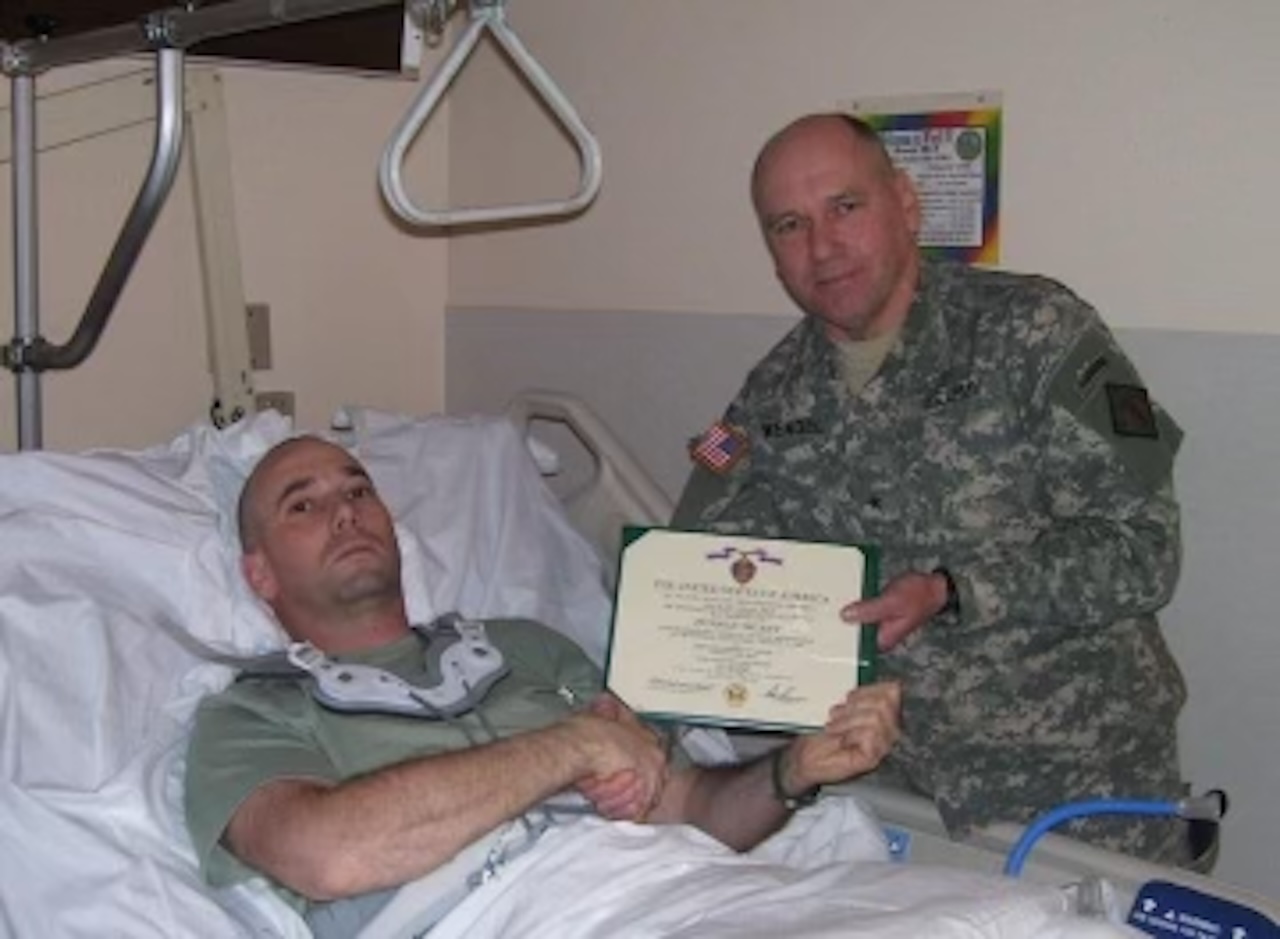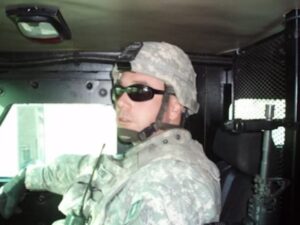Main Street News

Veteran Profile: Stephen Valyou
In honor of Veteran’s Day on November 11, we are profiling veterans from around the area all month long to honor their service. This installment features Stephen Valyou, an Army veteran.
When U.S. Army Staff Sergeant Stephen Valyou was shot in the chest, his first thought upon waking up from a two day coma was “When can I go back to Iraq?”
The short answer was never.
“That was the hardest part. Not being paralyzed or being in a wheelchair, but I was worried about getting back to Iraq. I still had work to do,” he said.
Enlistment and service
Stephen, who lives in Millerton, NY, enlisted in the army at 24 years old following 9/11. “I chose the Army because they could guarantee that I would go to Afghanistan,” he said. “I didn’t care what I did over there, but I wanted to be there.”
Stephen served in both Afghanistan and Iraq before he was honorably discharged in 2007.
In Afghanistan, he worked as a combat engineer and much of the work he did occurred at the border between Afghanistan and Pakistan. He said that rocket attacks and ambushes became so frequent that he could almost predict when they were going to happen on a daily basis. They also did foot patrols in the mountains and would set up observation points.
“We did some weapons clearance and some ammunition cache, but mostly we were observing what was going on and who was moving in,” he said. “Ambushes were so common. I would say that we were in at least one type of engagement like that per day. Towards the end of that deployment, I started working with EOD in Afghanistan.”
EOD, or Explosive Ordnance Disposal Specialists, are the Army’s tactical and technical explosives experts. They’re trained to defeat and exploit unexploded ordnance, explosive devices, and other weapons of mass destruction.
Following his return from Afghanistan, Stephen went to EOD school for about eight months, before returning to the Middle East, this time in Iraq.
In Iraq, Stephen operated as an EOD team leader, so much of his work was centered around finding and defeating roadside bombs, improvised explosive devices, and other explosives.
“We’d have anywhere from a handful to 15 or 20 incidents per day. We had two teams that were working on three different companies, so we were spread really thin. We were constantly running around. The day I got shot, we had been running for quite a long time.”
March 29, 2007
The day he got shot, March 29, 2007, was a day like any other for Stephen. He and his team had been responding to different incidents since midnight, and they were en route to another location when Stephen told the Bradley (a lightly armored transport vehicle used as security in armored cavalry combat) in front of their vehicle to stop 30 meters before the location they were assigned to.
“They said ‘That’s not where we’re supposed to be going,’ and I said, ‘I know, but let me get out and check anyway.’ It was a common location for explosives and we were passing right by. I couldn’t move on without checking it out,” he said.
Stephen ended up approaching the location three times in total to check for explosives: “Each approach is a different route. I never did the same thing twice. They were watching us, so I always did something different on each approach.”
On the third approach, he managed to clear the area of explosives, but as he turned around, he was shot in the side of his chest.
“I remember putting my thumb up in the air that it was all clear and my team could come get me, and then I got shot. I don’t remember hitting the ground, and 10 or 15 seconds later when I came to, I couldn’t feel my legs,” he said. “My first thought was that I missed a secondary [explosive] and that’s a failure as an EOD, so I’m yelling through the radio that I blew my legs off. One of my guys is yelling at me that I still have my legs, and sure as shit, I looked down and my feet were there.”
Stephen remembers feeling his back fill with blood as he was moved into the Bradley for transport. From there, things get a bit spotty.
 “I remember a little bit from inside the Bradley and I remember getting shot at while we were getting into the Medivac. As we landed in Balad, I remember getting pulled into the field hospital and telling the doctor that I needed him to make the pain go away. Next thing I know, they’re putting a mask over my face and I woke up two days later in Germany,” he said.
“I remember a little bit from inside the Bradley and I remember getting shot at while we were getting into the Medivac. As we landed in Balad, I remember getting pulled into the field hospital and telling the doctor that I needed him to make the pain go away. Next thing I know, they’re putting a mask over my face and I woke up two days later in Germany,” he said.
Stephen said that, according to his medical records, doctors had to bring him back three times during surgery.
“I had doctors tell me, ‘You shouldn’t be here. I don’t know how you’re sitting in front of me.’”
He was no stranger to injury. Stephen said that he’s been blown up three times and that he and his team would get ambushed and attacked weekly.
He shared one story of their 20,000 pound vehicle getting hit with an explosive that blew the transmission, the undercarriage, and the wheels off, and flipped and threw the entire vehicle nearly 30 meters down the road.
One of the worst situations he was in was down under a culvert disarming an explosive. Someone came into the culvert behind him and dropped a bag on the ground, which exploded before Stephen could do anything about it. That was his closest call with an explosive, and he came out of the incident with some shrapnel embedded in the back of his head and neck.
“You get into the pattern and the behavior. I’ve been hurt in both Afghanistan and Iraq, and you take some ibuprofen, drink some water, and move on. With concussions and explosions, they take you out of the field for 48 hours. But when I got shot … this was different.”
Memorable moments
One of the things that Stephen remembers most from his service is the camaraderie. “It’s a family away from family and it’s one of the biggest things that I miss. There’s a big void in your life when you come home from something like that,” he said.
Another thing he remembers is the resourcefulness of the Afghan people. “They could take anything and make something amazing out of it. Any piece of scrap metal and anything they could find, they would pile it up and make something of it,” he said. “The ingenuity of the farmers over there was incredible. They learned to do with nothing and still be able to survive.”
He also remembers the money.
“When I was in Afghanistan in 2003, I remember unloading a helicopter on the airfield and there were just boxes of money, I’m talking millions of dollars. Not just equipment and personnel, but the cash that got pushed around,” he explained. “The value of money and of the American dollar was very evident there.”
Life after service
Stephen said that the military impacted him in both positive and negative ways. While there are always memories that he wishes he didn’t remember, he believes that it created character or “turns you into something that maybe you never thought you were.”
“The military is good and it’s bad, and sometimes it’s it’s own worst enemy in terms of operational standards,” he said. “It’s given me patience. I’ve learned to tolerate the dumb stuff and then use what’s there out of the good stuff.”
Coming home from combat was difficult in that normal, every day life tends to lack the structure that is so prominent in the military on a daily basis. In the military, there also tends to be no breakdown of communication.
“On the civilian side, it’s not so regimented,” he said. “There’s lots of chiefs discussing how things are going to get done, rather than just one person giving you your orders.”
If there was one thing that Stephen wishes civilians understood about military service, it’s to “not judge a book by its cover.”
“Unless you’ve read the book, you don’t really know. I think that judgment happens more often than it probably should. I’m not saying that bad things don’t occur and haven’t occurred, but unless you’ve been in those situations, I don’t think it’s fair to cast a judgment against service people or the military in general.”
To learn more about the U.S. Army, visit their website here.


